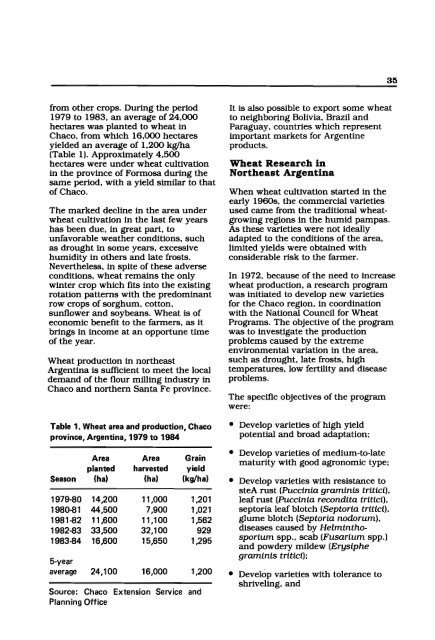the Symposium on Wheats for More Tropical Environments - cimmyt
the Symposium on Wheats for More Tropical Environments - cimmyt
the Symposium on Wheats for More Tropical Environments - cimmyt
- No tags were found...
You also want an ePaper? Increase the reach of your titles
YUMPU automatically turns print PDFs into web optimized ePapers that Google loves.
3~from o<str<strong>on</strong>g>the</str<strong>on</strong>g>r crops. During <str<strong>on</strong>g>the</str<strong>on</strong>g> period1979 to 1983, an average of 24,000hectares was planted to wheat inChaco, from which 16,000 hectaresyielded an average of 1,200 kglha(Table 1). Approximately 4,500hectares were under wheat cultivati<strong>on</strong>in <str<strong>on</strong>g>the</str<strong>on</strong>g> province of Formosa during <str<strong>on</strong>g>the</str<strong>on</strong>g>same period, with a yield similar to thatof Chaco.The marked decline in <str<strong>on</strong>g>the</str<strong>on</strong>g> area underwheat cultivati<strong>on</strong> in <str<strong>on</strong>g>the</str<strong>on</strong>g> last few yearshas been due, in great part, tounfavorable wea<str<strong>on</strong>g>the</str<strong>on</strong>g>r c<strong>on</strong>diti<strong>on</strong>s, suchas drought in some years, excessivehumidity in o<str<strong>on</strong>g>the</str<strong>on</strong>g>rs and late frosts.Never<str<strong>on</strong>g>the</str<strong>on</strong>g>less, in spite of <str<strong>on</strong>g>the</str<strong>on</strong>g>se adversec<strong>on</strong>diti<strong>on</strong>s, wheat remains <str<strong>on</strong>g>the</str<strong>on</strong>g> <strong>on</strong>lywinter crop which fits into <str<strong>on</strong>g>the</str<strong>on</strong>g> existingrotati<strong>on</strong> patterns with <str<strong>on</strong>g>the</str<strong>on</strong>g> predominantrow crops of sorghum, cott<strong>on</strong>,sunflower and soybeans. Wheat is ofec<strong>on</strong>omic benefit to <str<strong>on</strong>g>the</str<strong>on</strong>g> farmers, as itbrings in income at an opportune timeof <str<strong>on</strong>g>the</str<strong>on</strong>g> year.Wheat producti<strong>on</strong> in nor<str<strong>on</strong>g>the</str<strong>on</strong>g>astArgentina is sufficient to meet <str<strong>on</strong>g>the</str<strong>on</strong>g> localdemand of <str<strong>on</strong>g>the</str<strong>on</strong>g> flour milling industry inChaco and nor<str<strong>on</strong>g>the</str<strong>on</strong>g>rn Santa Fe province.It is also possible to export some wheatto neighboring Bolivia, Brazil andParaguay, countries which representimportant markets <strong>for</strong> Argentineproducts.Wheat Research inNor<str<strong>on</strong>g>the</str<strong>on</strong>g>ast ArgentinaWhen wheat cultivati<strong>on</strong> started in <str<strong>on</strong>g>the</str<strong>on</strong>g>early 1960s, <str<strong>on</strong>g>the</str<strong>on</strong>g> commercial varietiesused came from <str<strong>on</strong>g>the</str<strong>on</strong>g> traditi<strong>on</strong>al wheatgrOWingregi<strong>on</strong>s in <str<strong>on</strong>g>the</str<strong>on</strong>g> humid pampas.As <str<strong>on</strong>g>the</str<strong>on</strong>g>se varieties were not ideallyadapted to <str<strong>on</strong>g>the</str<strong>on</strong>g> c<strong>on</strong>diti<strong>on</strong>s of <str<strong>on</strong>g>the</str<strong>on</strong>g> area,limited yields were obtained withc<strong>on</strong>siderable risk to <str<strong>on</strong>g>the</str<strong>on</strong>g> farmer.In 1972, because of <str<strong>on</strong>g>the</str<strong>on</strong>g> need to increasewheat producti<strong>on</strong>, a research programwas initiated to develop new varieties<strong>for</strong> <str<strong>on</strong>g>the</str<strong>on</strong>g> Chaco regi<strong>on</strong>, in coordinati<strong>on</strong>with <str<strong>on</strong>g>the</str<strong>on</strong>g> Nati<strong>on</strong>al Council <strong>for</strong> WheatPrograms. The objective of <str<strong>on</strong>g>the</str<strong>on</strong>g> programwas to investigate <str<strong>on</strong>g>the</str<strong>on</strong>g> producti<strong>on</strong>problems caused by <str<strong>on</strong>g>the</str<strong>on</strong>g> extremeenvir<strong>on</strong>mental variati<strong>on</strong> in <str<strong>on</strong>g>the</str<strong>on</strong>g> area,such as drought, late frosts, hightemperatures, low fertility and diseaseproblems.The specific objectives of <str<strong>on</strong>g>the</str<strong>on</strong>g> programwere:Table 1. Wheat area and producti<strong>on</strong>, Chaco • Develop varieties of high yieldprovince, Argentina, 1979 to 1984potential and broad adaptati<strong>on</strong>;• Develop varieties of medium-to-IateArea Area Grainmaturity with good agr<strong>on</strong>omic type;planted harvested yieldSeas<strong>on</strong> (ha) (ha) (kg/ha) • Develop varieties with resistance tosteA rust (Pucctnia graminis tritici),1979-80 14,200 11,000 1,201 leaf rust (Pucctnia rec<strong>on</strong>dita tritict),1980-81 44,500 7,900 1,021 septoria leaf blotch (Septoria tritici),1981-82 11,600 11,100 1,562 glume blotch (Septoria nodorum),1982-83 33,500 32,100 929 diseases caused by Helmtnthosportum1983-84 16,600 15,650 1,295spp., scab (Fusartum spp.)and powdery mildew (Erystphegraminis trtttci);5-yearaverage 24,100 16,000 1,200 • Develop varieties with tolerance toshriveling, andSource: Chaco Extensi<strong>on</strong> Service andPlanning Office

















